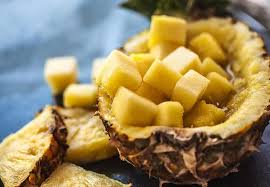Pineapple Paradise: Exploring the Sweet and Tangy World of Tropical Fruit

The Delicious and Versatile Pineapple
Pineapple, with its sweet and tangy flavor, is a tropical fruit that is beloved by many around the world. This spiky fruit is not only delicious but also packed with essential nutrients.
Native to South America, pineapples are now grown in tropical regions across the globe. They are rich in vitamin C, manganese, and antioxidants, making them a healthy addition to any diet.
One of the most popular ways to enjoy pineapple is fresh and ripe, either on its own or as part of a fruit salad. Its juicy flesh and vibrant taste make it a refreshing treat on a hot day.
Pineapple is also a versatile ingredient in both sweet and savory dishes. It can be grilled for a caramelized flavor, blended into smoothies for a tropical twist, or used in desserts like pineapple upside-down cake.
Aside from its culinary uses, pineapple has also been used for its medicinal properties. It contains an enzyme called bromelain, which has anti-inflammatory properties and may aid in digestion.
Whether enjoyed fresh, cooked, or juiced, pineapple is a delightful fruit that adds a burst of flavor to any dish. So next time you’re at the grocery store, be sure to pick up a pineapple and savor its tropical goodness!
7 Essential Tips for Selecting, Storing, and Savoring Pineapples
- Choose pineapples that are heavy for their size and have a sweet smell at the base.
- To store a whole pineapple, keep it at room temperature for 1-2 days or in the refrigerator for up to 4 days.
- To ripen a pineapple faster, place it upside down at room temperature for a day before cutting.
- Cut off the crown and base of the pineapple, then stand it upright to easily slice off the skin in strips.
- Remove any ‘eyes’ left on the pineapple after peeling by making shallow diagonal cuts around them.
- Pineapple pairs well with savory dishes like grilled chicken or pork, as well as in sweet desserts like fruit salads or upside-down cakes.
- Use leftover pineapple juice in marinades, cocktails, smoothies, or as a natural meat tenderizer.
Choose pineapples that are heavy for their size and have a sweet smell at the base.
When selecting a pineapple, it is advisable to choose ones that feel heavy for their size and emit a sweet smell at the base. The weight indicates juiciness and ripeness, while the sweet aroma at the base suggests that the fruit is flavorful and ready to be enjoyed. By following this tip, you can ensure that you pick a delicious and ripe pineapple for your culinary creations or snacking pleasure.
To store a whole pineapple, keep it at room temperature for 1-2 days or in the refrigerator for up to 4 days.
To store a whole pineapple, it is recommended to keep it at room temperature for 1-2 days to allow it to ripen further. If you prefer a chilled pineapple, you can store it in the refrigerator for up to 4 days. Keeping the pineapple refrigerated helps maintain its freshness and extends its shelf life, ensuring that you can enjoy its sweet and tangy flavor for several days after purchase.
To ripen a pineapple faster, place it upside down at room temperature for a day before cutting.
To ripen a pineapple faster, a useful tip is to place it upside down at room temperature for a day before cutting into it. This method helps distribute the sugars more evenly throughout the fruit, resulting in a sweeter and juicier pineapple when it’s ready to be enjoyed. By allowing the pineapple to ripen upside down, you can enhance its flavor and make it even more delicious for your next culinary creation.
Cut off the crown and base of the pineapple, then stand it upright to easily slice off the skin in strips.
To prepare a pineapple efficiently, start by cutting off the crown and base of the fruit. With the pineapple standing upright, carefully slice off the skin in strips. This method not only makes it easier to remove the tough outer layer but also allows for neat and uniform slices of delicious pineapple ready to enjoy. By following this tip, you can quickly and effectively prepare this tropical fruit for your culinary creations or simply as a healthy snack option.
Remove any ‘eyes’ left on the pineapple after peeling by making shallow diagonal cuts around them.
After peeling a pineapple, it’s important to remove any remaining ‘eyes’ by making shallow diagonal cuts around them. These small, indented spots can be tough and unappealing to eat, so by carefully slicing them out, you can ensure a smoother and more enjoyable eating experience. This simple tip not only improves the presentation of the pineapple but also enhances its texture, making each juicy bite even more delightful.
Pineapple pairs well with savory dishes like grilled chicken or pork, as well as in sweet desserts like fruit salads or upside-down cakes.
Pineapple’s versatile flavor profile makes it a perfect complement to a wide range of dishes. Its sweet and tangy taste pairs beautifully with savory dishes such as grilled chicken or pork, adding a refreshing and tropical twist to the meal. Additionally, pineapple’s natural sweetness makes it a popular choice for sweet desserts like fruit salads or classic upside-down cakes, where its juicy texture and vibrant flavor shine through, creating a delightful culinary experience for all who enjoy it.
Use leftover pineapple juice in marinades, cocktails, smoothies, or as a natural meat tenderizer.
Leftover pineapple juice can be a versatile ingredient in the kitchen. Instead of letting it go to waste, consider using it in various ways to enhance your dishes and drinks. Pineapple juice can be added to marinades to impart a sweet and tangy flavor to meats or vegetables. It also works well in cocktails, adding a tropical twist to your favorite drinks. Additionally, you can blend it into smoothies for a refreshing and fruity boost, or use it as a natural meat tenderizer due to its enzymatic properties. Next time you have leftover pineapple juice, get creative and explore the many ways you can incorporate it into your culinary creations!
